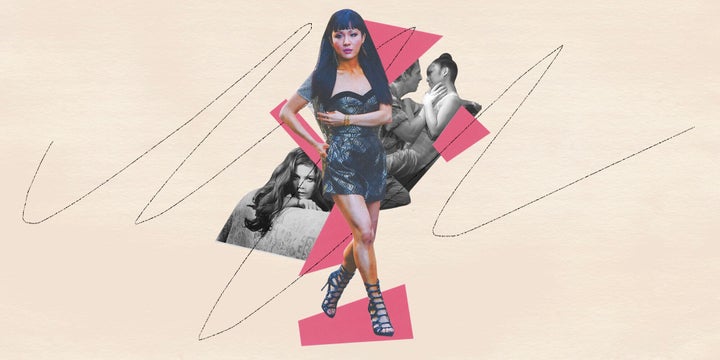
On the rooftop of a Manhattan strip club in one of the opening scenes of box office hit “Hustlers,” Jennifer Lopez’s character Ramona says to fellow stripper Destiny, portrayed by Constance Wu, “You’re new, you’re gorgeous, you’re Asian — you’re a triple threat.” Before this scene, we get a glimpse into the life of Asian American protagonist Destiny: She is struggling to take home enough money after exploitative managers and security at the strip club whittle down her wages, and audiences see her at home in Queens trying to provide for her aging grandmother.
Already, within the first few moments of the film, Destiny embodies the most nuanced portrayal of an Asian sex worker in Hollywood’s long history of reducing them to age-old stereotypes about Asian women. In the West, representations of Asian women in popular culture are often relegated to the same limiting roles: the ultra-feminine, innocent and sexually submissive “lotus blossom,” the model minority and the sexually aggressive, domineering “dragon lady,” to name a few. One trope used time and time again is the Asiatic prostitute, where Asian women are often depicted in Western narratives as sex workers or sex slaves.
Perhaps one of the most memorable scenes featuring an Asian sex worker in a contemporary Hollywood film is from Stanley Kubrick’s “Full Metal Jacket” (1987), in which a Vietnamese prostitute solicits two American GIs by telling them, “Me so horny ... me love you long time.” The film’s depictions of the Vietnamese sex workers offer nothing of their personalities, histories or inner lives, only that they are women with degenerate values and bodies to be exploited by the men.
The idea that all Asian women are prostitutes hasn’t come solely from stereotypes in Western media; it was also perpetuated by U.S. immigration law. The Page Act of 1875, the first law to restrict immigration into the country, effectively halted the immigration of East Asian women (namely Chinese women) to the U.S., under the assumption that they were all prostitutes and undesirable immigrants.
“Such legalized exclusion of Chinese women popularized American representations of them as degrading figures that could potentially debase white manhood and, as such, threaten the health of the United States’ social body as a modern nation and imperial power,” Lily Wong, an associate professor at American University, wrote in “Transpacific Attachments,” which studies the shifting depiction of Chinese and Chinese American sex workers in transpacific popular media. “The legalized policing of Chinese female bodies justified both anti-Chinese ‘yellow peril’ discourse and U.S. civilizing rescue narratives of imperial expansion into Asia.”
It is unsurprising, then, that a lion’s share of the most popular on-screen and onstage productions starring Asian actresses fed into this exact discourse of the Western white savior going to the East and being seduced by an Asian woman. Both “The World of Suzie Wong” (1960) and Claude-Michel Schönberg and Alain Boublil’s hit musical “Miss Saigon” feature Asian sex workers as female leads, both of whom play the role of a “hooker with a heart of gold” while simultaneously embodying the lotus blossom stereotype.
“The World of Suzie Wong” stars Cantonese-European actress Nancy Kwan in the title role. In the film, Suzie Wong, a Hong Kong prostitute, becomes the love interest to American architect Robert Lomax. Film scholar Celine Parreñas Shimizu wrote about Suzie in her book “The Hypersexuality of Race”: “Despite incredible hardship as an illiterate prostitute with an illegitimate son, she maintains her goodness, beauty, and innocence.”
“She embodies immoral practices while projecting an innate innocence,” Shimizu wrote, so it is only ever Suzie, the lotus blossom, who was exploited by men. In “Hustlers,” while Destiny maintains some of her innocence by labeling Ramona as the ringleader, she and the rest of her stripper posse flip the script by exploiting their white male clients (by drugging them and stealing their money). Meanwhile, Suzie is the picture of subservience, promising her dedication to Robert by saying, “I will follow you until you say, ‘Suzie, go away,’” and asking him in another scene, “Robert, why you not let me be your permanent girlfriend?”
Suzie was forced into the sex trade after being abandoned at 10 years old. Her character is a mirror to Kim, the female lead in “Miss Saigon,” a 17-year-old Vietnamese bargirl who also exemplifies the prostitute with a heart of gold archetype. Kim falls in love with and marries a U.S. Marine who leaves once the war is over, and she waits for his return for three years — with their love child. When they reunite, the man is with his new American wife, whom Kim meets, triggering her to ultimately kill herself. The musical has long been protested by Asian American activists for its racist, sexist and Orientalist depictions, as well as for yellowface controversies.
These more contemporary stories are spawned from earlier texts, which all replicated the same repeated tropes. “Miss Saigon” is actually based on Giacomo Puccini’s 1904 opera “Madama Butterfly,” which instead followed the doomed romance between an American lieutenant and a Japanese geisha. Before that, “Madama Butterfly” was inspired by “Madame Chrysanthème,” an 1887 semi-autobiographical novel about naval officer Pierre Loti’s temporary marriage to a Japanese woman named Kiku. These recurrent storylines perpetuate the image of the Asian woman as war brides, geishas and prostitutes, all of whom lack agency and live to serve the white male lead. Meanwhile, Destiny’s purpose in life seems much more layered: to find a sense of belonging, to take care of her family, to chase thrills, to succeed in life. And we can tell that aspects of her job excite her, exhaust her and bore her at the same time.
However, in “Miss Saigon,” when the non-lead prostitute characters were allowed to display their inner lives on stage, audiences view them as desperate and suffering.
“The production of ‘Miss Saigon’ may actually represent other ‘particular women in the sex industry’ beyond those enmeshed within conditions of sexual slavery,” Shimizu wrote. “While sexual slavery indeed exists for Asian female prostitutes, other situations coexist simultaneously in ways that should not be removed.”
However, thanks to persistent stereotypes like those deployed in Suzie and Kim’s characters, Asian sex workers, especially those who are migrants, are often assumed to be trafficking victims.
The perpetuation of this stereotype has expressed itself in real-life police practices, which play out Western savior narratives. For example, Asian massage parlors were recently targeted in anti-trafficking stings in Florida, though no one has been charged with human trafficking. (These spa raids were made infamous for leading to Patriots owner Robert Kraft’s arrest.) In New York, similar crackdowns have led to the shuttering of parlors in the Flushing neighborhood of Queens, Manhattan, and Long Island in the past couple years, often leading to arrests. And typically, the people harmed most by these anti-trafficking raids are the women themselves.
Hollywood’s insistence on stereotyping Asian women as helpless, innocent lotus blossoms has been met with inevitable consequences, like the fetishization of Asian women, and even some unintended ones, like a hammer-wielding man who killed Chinese men to “protect” Chinese women from them after watching an unspecified movie.
While Wu’s character in “Hustlers” is leaps and bounds better than the characters that came before, presenting a more nuanced and dimensional portrayal of an Asian sex worker on screen, there are still ways in which she fits into the same lineage as Suzie, Kim and Madame Butterfly.
“Destiny still maintains a bit of the Asian American ingenue innocence as Ramona’s protege,” Kate Zen, co-founder of Red Canary Song, an organization that advocates for the rights of migrant sex workers, said in an interview. “She ultimately caved in interrogation and sold out the group to the police, in a way that might arguably be retaining the model minority myth.”
Sex workers had many other criticisms of the film, from maintaining “the whorearchy” by portraying the Russian dancers who were willing to give blow jobs as lesser than to ignoring the fact that strippers are often the victims of crimes rather than the perpetrators.
“The dimensionality is positive,” Zen said, “though the focus on drugging and robbing customers also perpetuates stigma against sex workers and is a bit of an aberration from the reality of stripping, where strippers are more likely to get drugged by customers than the other way around.”
Brooke, a 20-year-old former stripper from the Chicago area, pointed out that while “Hustlers” does some work to destigmatize the sex trade, she wishes it would’ve shed more of a light on the abuses and racialized harassment endured by Asian sex workers.
“I was told on my first night that being Asian equals money, but they fail to tell you how many times you’ll hear, ‘I’ve never fucked an Oriental girl,’” Brooke, who requested to not use her last name in regard for her privacy, told HuffPost in an interview. “I had many people excited just to see an Asian dancing, thought I was naturally into certain things like being dominated and bossed around, and also treated like a disgrace by Asian men who came into the club.”
Still, in “Hustlers,” audiences are treated to a more well-rounded portrayal of an Asian stripper, whose complex inner life is revealed to us on-screen — one that we nearly missed out on, given Dakota Johnson was initially considered for the lead role. (Though perhaps a Southeast Asian actress would’ve been even better casting, considering the real life stripper Destiny was based off of is Rosalyn Keo, who is Cambodian.)
Ultimately, the portrayal of Asian sex workers on screen has come a long way since the “me so horny” streetwalker, which is especially important given the inextricable ties between the treatment of Asian women in real life and our on-screen depictions.
“It’s so positive for us to see ourselves portrayed at all,” Zen said. “What a breath of fresh air!”
